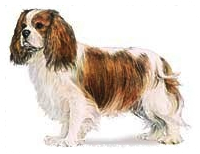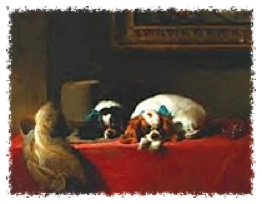Enter Text
HISTORY
Historically, Toy Spaniels have been associated with English nobility dating back to the fifteenth Century. They were kept by Mary Queen of Scots, Charles I, Charles II, and The Duke of Marlborough. Through the centuries, however, the King Charles Spaniel (different from the Cavalier King Charles Spaniel, see below) gained popularity, and the Cavalier’s numbers dwindled to almost extinction by the late Victorian era. The nearest breed to the cavalier at that time was the Toy Spaniel, which in 1923 became known as the King Charles Spaniel (English Toy Spaniel).
in the mid 1920’s an American became enamored with the Cavalier type that he had seen in older paintings by artists such as Sir Edwin Landseer (below). In 1926, he offered monetary awards at the Crufts dog show for spaniels that resembled these “longer muzzled” dogs but was unsuccessful. Each year for the next five years he offered the same prize. In 1928 he acquired his “winner”. It was this dog that was used to set the Standard for the breed when a small group of breeders at Crufts formed The Cavalier King Charles Spaniel Club that same year. Cavaliers were first sent to The United States in 1952, and since then the breed has slowly increased in popularity. The breed was officially recognized by the American Kennel Club in 1996, becoming the 140th AKC breed.
Sir Edwin Landseer
"The Cavalier's Pets"
1845; Tate Gallery, London



BREED STANDARD
The Cavalier King Charles Spaniel is outgoing, affectionate sporting, and fearless. They are a friendly breed that can often be found following alongside the footsteps, or in the lap of their owner. With proper supervision they are excellent with children. They are about 12 to 13 inches at the withers, and should weigh between 13 to 18 pounds.
There are four acceptable colors:
• Blenheim Bright chestnut-red markings on a pearly white background. The ears must be red, with evenly spaced color on the head, and a white blaze between the ears in the middle of which is a desired (not essential) “Blenheim spot.”
• Tricolor Jet black markings broken up on a pearly white background.Tan markings over the eyes, on the cheeks, inside the ears and under the tail.
• Ruby Whole colored, rich red.
• Black and Tan Jet black with tan markings over the eyes, on the cheeks, inside the ears, and under the tail.
Click to view full AKC Breed Standard
GROOMING
Despite their elegant appearance, cavaliers actually require only little day to day maintenance. They are fairly easy to keep cleaned and well groomed. A daily brushing in between biweekly baths is the best way to keep them clean. A good firm daily brushing will help prevent matting and will stimulate the skins natural oil production. The ears should be cleaned weekly to stay healthy. This will also indirectly help control tear staining. In some Cavaliers the eyes will weep or tear, especially during teething, and should be wiped clean once or twice a day. The Cavalier coat never needs to be trimmed, and in fact doing so goes against “breed standard”. Toe-nails should be clipped every few weeks.
HEALTH CONCERNS
Modern Veterinary science has gained considerable advances over the last several decades, and the ability to diagnose and treat medical conditions affecting Cavaliers has never been better. As breeders/owners and scientists pool information such as pedigree records and genetic databases the ability to isolate genetic causes of inheritable diseases becomes a possibility potentially wiping out serious disease states in the cavalier.
The old saying an ounce of prevention is worth a pound of cure is as true for canines as it is for humans. First, in order to stay healthy we must start healthy. For example, a puppy that comes from a breeder that has carefully screened their breeding stock is less likely to become affected with inheritable diseases. Good genes, however, mean only so much. A dog owner should select a well qualified veterinarian and have their dog vaccinated against infectious diseases, and follow up for routine health check –ups. Additionally, the yard should be fenced and the dog walked on a leash.
The Cavalier is genetically prone to several specific diseases. The following diseases are not specific to the Cavalier but are found more commonly in this breed than in other dogs.
• Mitral Valve Disease: Studies have shown that by the age of five, fifty percent of Cavaliers have mitral valve regurgitation. Unfortunately, the incidence and severity increases with age. Many cases are subclinical (i.e. the murmur can be heard with a stethoscope, but the dog has no symptoms). In more serious cases the disease can lead to left sided heart enlargement and subsequent congestive heart failure. Many affected dogs can, however, live long lives with medical treatment. Symptoms include exercise intolerance, and cough in the early stages. The disease can be diagnosed by auscultation (listening to the heart with a stethoscope) or by echocardiography.
• Syringomyelia: This disease is caused by an obstruction in the flow of cerebrospinal fluid. This obstruction can occur anywhere along the spinal cord, but most commonly is located at the foramen magnum which is the hole at the base of the scull where the spinal cord begins. Because of the blockage of fluid (CSF) flow, cysts, called syrinx, form, resulting in the deterioration and destruction of parts of the spinal cord. The result is pain and potentially crippling effects. Conservative estimates are that at least 50% of the breed is affected, though only a small proportion manifests clinical symptoms. Classic signs include pain in the neck area. This can result in the dog being overly sensitive to touch around the nape of the neck. Affected dogs often tend to scratch the neck, especially when walking on a lead. Diagnosis is made by MRI. Treatment includes pain medication, anti-inflammatory medication, and possibly surgical intervention. The identification of this disease as it applies to Cavaliers is relatively recent. Scientists and breeders are still debating its prevalence and impact on the breed. Currently, programs are underway conducting research into the causes of the above two diseases. Specifically, DNA is being collected in attempt to isolate the specific genetic mutations.
